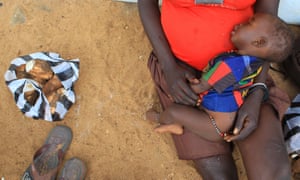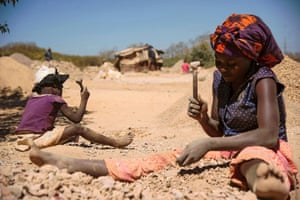Nearly half all children in sub-Saharan Africa in extreme poverty, report warns
Eradicating extreme poverty by 2030 seems a distant target as Unicef-World Bank figures show almost 385 million children survive on less than $1.90 a day

Nearly half of all children in sub-Saharan Africa are living in extreme poverty, according to a joint Unicef-World Bank report released on Tuesday, with figures showing that almost 385 million children worldwide survive on less than $1.90 (£1.50) a day, the World Bank international poverty line.
Extreme poverty leads to stunted development, limited future productivity as adults, and intergenerational transmission of poverty, the report (pdf) says. The figures – based on data from 89 countries, and representing 84% of the developing world’s population – indicate that much work will be needed to meet the sustainable development goal of eradicating extreme poverty by 2030.
Children are disproportionately affected by extreme poverty – they make up just a third of the population studied, but comprise half of the extreme poor. They are twice as likely as adults to be living on less than $1.90 a day, the report claims, with 19.5% of children in developing countries living in extremely poor households, compared to just 9.2% of adults.
“It’s almost a double blow – firstly, that children are twice as likely as an adult to live in extreme poverty, but also that children are much less likely than an adult to be able to cope with extreme poverty because of stunting, infant mortality, and early childhood development,” said Unicef’s deputy executive director, Justin Forsyth.
“Extreme poverty can either kill you, or ruin your potential for the rest of your life.”
The report follows the release of World Bank data looking at inequality and poverty worldwide, which found that half of the 767 million people living on less than $1.90 per day in 2013 were under 18.
While extreme poverty rates have been halved since 1990, according to the UN, the magnitude of the latest figures indicates that a big funding push will be essential to reverse trends by 2030, says Ana Revenga, senior director of Poverty and Equity at the World Bank Group.
“The sheer number of children in extreme poverty points to a real need to invest specifically in the early years – in services such as pre-natal care for pregnant mothers, early childhood development programmes, quality schooling, clean water, good sanitation and universal healthcare,” said Revenga.
“Improving these services, and ensuring that today’s children can access quality job opportunities when the time comes, is the only way to break the cycle of intergenerational poverty that is so widespread today.”
Based on the limited data in the sample, sub-Saharan Africa not only has the highest percentage of children living in extreme poverty (49%), it is home to the largest share of the world’s extremely poor children (51%). South Asia has the second highest share (36%). One of the most tell-tale signs of extreme poverty is stunting: about 25% of children under the age of five are so under-nourished that they are too short for their age.
The data shows that children in rural areas are nearly three times more likely to live in extreme poverty than those in urban areas. But even children in households with higher incomes are disproportionately affected by poverty: around 45% of children are living in households surviving on less than $3.10 per person per day, compared to just 27% of adults.

Nations affected by conflict, political instability and poor economic management have a higher number of children living in extreme poverty, the data shows. More than half (58%) of children living in such countries live in extremely poor households, according to the report, increasing their risk of inadequate education, healthcare and nutrition. Extreme poverty also increases a child’s risk of being exploited and abused.
Unicef and the World Bank are calling on governments to include children in poverty reduction plans and ensure that child poverty is routinely measured and addressed at national levels. Child-sensitive social protection systems, such as cash transfer programmes that pay families directly, are also useful in helping eradicate extreme poverty among children, the report notes.
“This is kind of a wake-up call for everyone in the world who’s thinking about their national poverty plans,” said Forsyth. “We have to look through the ‘children’ lens now – not just children but women and children. We’ve got to focus on things that will particularly benefit very poor families, and very poor children.”